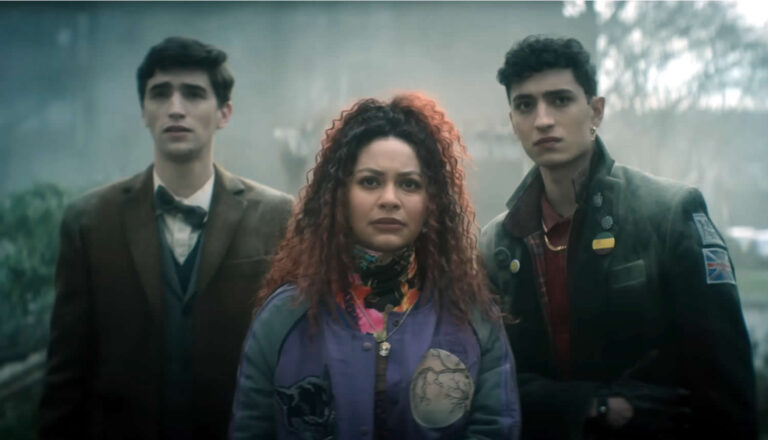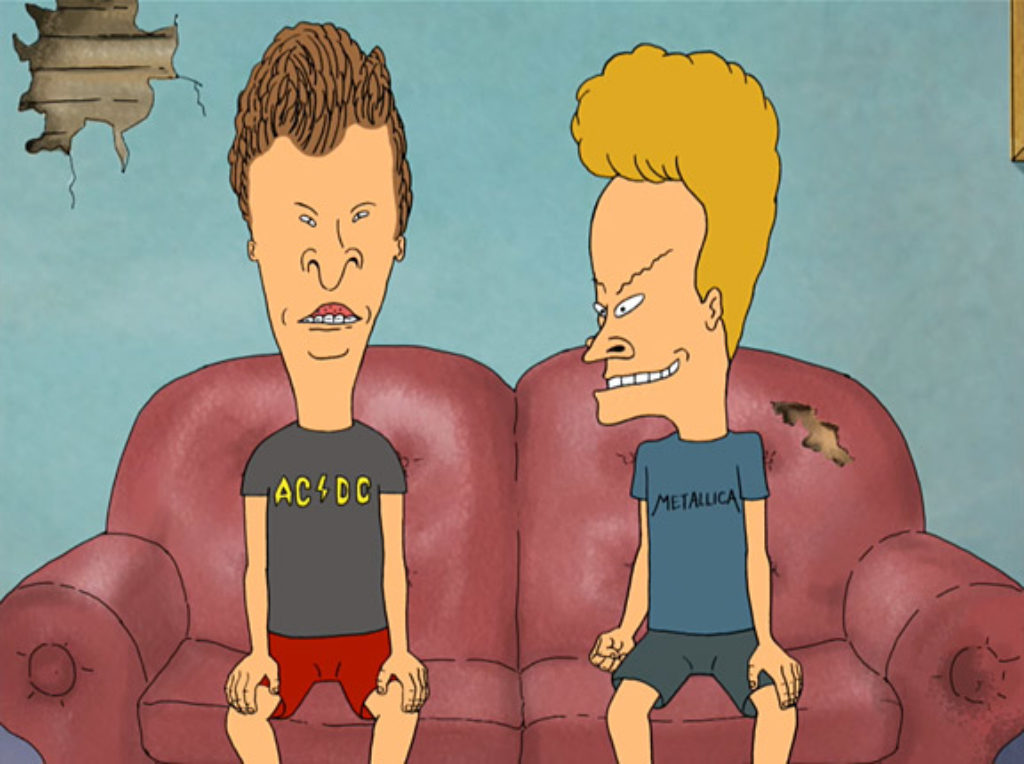
Dead Boy Detectives
Dead Boy Detectives targets teens in style and story. But it comes with very adult, problematic content.

In the early age of adult-targeted television animation—before Stewie had hatched his first nefarious plot on Family Guy; before Stan and Kyle had hurled their first profanity on South Park; before Maude Flanders was killed by a T-shirt cannon on The Simpsons—there was Beavis and Butt-head.
Lots of folks now know Mike Judge for his King of the Hill series on Fox. (It ran from 1997 through 2010.) But it was four years earlier, in 1993, that he launched his landmark satire of—and salute to—adolescent stupidity on MTV’s still-hip shores. Beavis and Butt-head featured two teen doofuses (doofi?) with a yen for girls, fire and heavy metal, and who were at their happiest—and most cogent—while watching music videos. When they dared get off their couch things got messy: Invariably, they’d wind up trashing their neighbor’s yard or destroying a teacher’s beloved eight-track collection or driving Principal McVicker to guzzle gallons of Old Crow.
Now, after a 14-year respite, the boys are back—back on the couch, back in school, back to their old exploits on MTV. Even their moldering Metallica and AC/DC shirts are back, making them look as though they’d been stored in a cryogenic freezer and simply dug their way out. Never mind that MTV dumped its music videos for reality television a long time ago. Pay no attention to the fact that the United States has been through three presidential elections, two wars and an interminably long recession. To paraphrase Mike Judge himself, stupidity never goes out of style.
The original Beavis and Butt-head was as moral-free a half-hour on TV as one was likely to find in the ’90s—”a satirical exaggeration of American instant-gratification taken to its logical extreme,” according to Time television critic James Poniewozik. “[Beavis and Butt-head] represented—on pop culture’s most prominent outlet—a brutally funny takedown of pop culture and the dumb, lazy egocentrism it catered to. The sugar rush of empty-calorie consumer society, it told us, makes Cornholios of us all.”
But not everyone found the show funny. Social critics contended that Beavis’ and Butt-head’s antics sometimes influenced youth in the real world. And MTV paid them some mind, too, deciding to stop pyromaniac Beavis from uttering the word fire after a 5-year-old boy allegedly set his own house ablaze, killing his 2-year-old sister. (He’d supposedly been watching the show, but doubt was cast on the cause-and-effect scenario months later when friends insisted the family didn’t even have cable.) Forget about whether the tragedy was triggered by the boys, critics said: Beavis and Butt-head was still a horrible influence on the culture. And MTV soon sequestered the series to an 11 p.m. timeslot and started including a disclaimer:
“Beavis and Butt-head are not real. They are stupid cartoon people completely made up by this Texas guy whom we hardly even know. Beavis and Butt-head are dumb, crude, thoughtless, ugly, sexist, self-destructive fools. But for some reason, the little wienerheads make us laugh.”
Perhaps it’s a sign of the times that this new iteration feels almost warmly nostalgic. No, it’s not any better: It’s just as stupid and profane as ever (and Beavis even gets to obsess over fire again). But while the show was pushing the envelope in the early ’90s, its content utterly fails to shock now—not in a television landscape that includes the likes of Jersey Shore, The Walking Dead and Sons of Anarchy. It is, in a very (very) strange way, a little of what The Lawrence Welk Show was in the early days of MTV itself—a reminder of a more “innocent” time.
But even in all its retro-salacious stodginess, Beavis and Butt-head still has the ability to satirize the culture surrounding it. And in some ways, the fact that Butt-head still wears braces after 22 years could be read as the ultimate poke. Consider: We live in an age obsessed with youth, an age in which we pride ourselves on never growing up. Fortysomethings shop at Forever 21 and celebrities Botox themselves into a state of freakish plasticity in the pursuit of eternal agelessness. Perhaps these two boys, still as young, immature and rudderless as ever, speak tomes to our obsession with youth—and suggest, in their own ridiculous and profane way that it’s OK to grow up after all. Indeed, that if you don’t, you’re doomed to remain as dumb as they are.
“Werewolves of Highland/Crying”
Beavis and Butt-head are introduced to the “fact” that vampires and werewolves are so popular because “they have conquered death and have been touched by evil, so they’re forbidden,” making them “irresistible to women.” The two immediately decide they want a piece of that, so they bribe a snaggletoothed homeless man (whom they mistake for a werewolf) to bite them. He does so repeatedly, producing huge red gashes and welts all over their bodies, and infecting them with, among other things, staph, gonorrhea and hepatitis A, B and C. But even while in comas at the hospital they start giggling when the nurse changes their catheters.
Elsewhere, Beavis starts weeping while the two watch The Bachelor. The tears are actually precipitated by an onion, but that doesn’t stop Butt-head from mocking his pal for his supposed sensitivity. (He’s still doing it decades later when Butt-head keels over dead in a retirement home.)
The two make crude references to anatomical body parts. They mock Jersey Shore, lamenting, “This is another one of those episodes where they don’t have sex and they don’t fight.” They slam J-Woww for calling her made-up grandkids “b‑‑ch.” “You’re the best grandma ever, Grandma J-Woww,” says Butt-head. “Please don’t hit us again,” says Beavis. They take issue with a video (which we see too) in which a child cries from fright when he’s accosted by mangled bodies and gory undead predators. And they watch another featuring a magic-doling preschooler who tortures a man (whom they brand as a child molester). Characters say “d‑‑n,” “a‑‑,” “h‑‑‑,” “b‑‑ch” and, of course, “butthole.”


Paul Asay has been part of the Plugged In staff since 2007, watching and reviewing roughly 15 quintillion movies and television shows. He’s written for a number of other publications, too, including Time, The Washington Post and Christianity Today. The author of several books, Paul loves to find spirituality in unexpected places, including popular entertainment, and he loves all things superhero. His vices include James Bond films, Mountain Dew and terrible B-grade movies. He’s married, has two children and a neurotic dog, runs marathons on occasion and hopes to someday own his own tuxedo. Feel free to follow him on Twitter @AsayPaul.

Dead Boy Detectives targets teens in style and story. But it comes with very adult, problematic content.

An elf mage contemplates on connection and regret as she watches her human friends grow old and pass away.